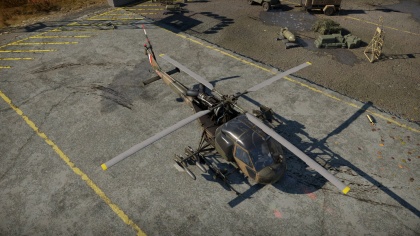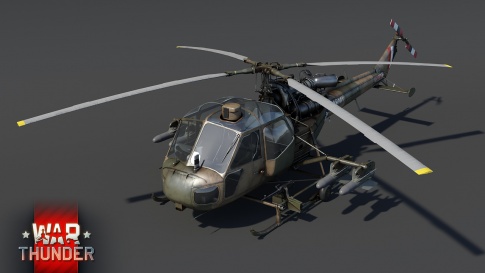Difference between revisions of "Scout AH.Mk.1"
(added history, pros, cons, performance, how to use, and a few other things) (Tag: Visual edit) |
m (added images and removed redundant info) (Tag: Visual edit) |
||
| Line 9: | Line 9: | ||
== General info == | == General info == | ||
=== Flight performance === | === Flight performance === | ||
| − | |||
| − | |||
| − | |||
{| class="wikitable" style="text-align:center" | {| class="wikitable" style="text-align:center" | ||
| Line 24: | Line 21: | ||
! AB !! RB | ! AB !! RB | ||
|- | |- | ||
| − | | ??? || | + | | ??? || 211 || {{Specs|ceiling}} |
|- | |- | ||
! colspan="3" | ''Upgraded'' | ! colspan="3" | ''Upgraded'' | ||
| Line 74: | Line 71: | ||
== Media == | == Media == | ||
| + | [[File:Scout 03 128.jpg|none|thumb|485x485px]] | ||
| + | [[File:Scout 280h7.jpg|none|thumb|485x485px]] | ||
== See also == | == See also == | ||
Revision as of 13:28, 23 October 2019
Contents
Description
The Scout AH.Mk.1 is a rank V British helicopter
with a battle rating of 8.7 (AB/SB) and 8.3 (RB). It was introduced in Update 1.91 "Night Vision".
General info
Flight performance
| Characteristics | ||
|---|---|---|
| Stock | ||
| Max Speed (km/h at 1,000 m) |
Max altitude (meters) | |
| AB | RB | |
| ??? | 211 | 5400 |
| Upgraded | ||
| Max Speed (km/h at 1,000 m) |
Max altitude (meters) | |
| AB | RB | |
| ??? | ??? | 5400 |
Survivability and armour
The Scout does not fly with any protective armour or bullet-proof glass, which if installed would decrease the Scout's ability to complete its mission. As such, the pilot must take this into account and fly the helicopter accordingly. Bull rushing right into the middle of a battlefield usually ends with disastrous results as the without armour, the Scout has nothing but thin metal fuselage coverings to protect the crew and vital equipment. The engine, transmission, main rotor and tail rotors are all exposed to fire from missiles, rockets, cannons and even small calibre machine guns.
Armaments
Offensive armament
- Guns: 2 x L7 GPMG machine guns
Suspended armament
- Missiles: 4 x SS.11 anti-tank guided missiles
Usage in battles
As the engine, transmission, main rotor and tail rotors are all exposed to enemy, the pilot must be aware of their surrounds and work to fight from the enemy vehicles blind spots or weak sides, because a burning and crashed helicopter only pads the enemies' score-count. Pick and choose your battles to preserve the helicopter.
Pros and cons
Pros
- Light and nimble
- Small profile
Cons
- Limited weaponry
History
Development on the Westland Scout began in the late 1950s, however not at the Westland company, but at Saunders-Roe. Saunders-Roe developed their Saro P.531 light utility helicopter, which itself was based on the design of a previous piston-powered helicopter. The Saro P.531 already had several prototypes built and tested by the time the company was acquisitioned by Westland, who in turn, decided to continue development of the P.531.
As a result, in the early 1960s, the Westland Scout was created. The Scout conducted its maiden flight in August 1960 and was well-received with both the British Army and Royal Navy during testing. Following the favorable reception, the helicopter was subsequently ordered into production for the Army as the Scout AH Mk.1.
As work on the Scout steadily progressed, Westland continued developing a navalised version of the vehicle in parallel. The ‘Sea Scout’, as it was initially designated, only featured several minor design differences from the base model, such as a wheeled undercarriage and foldable blades and tail section, along with some other differences. After being reviewed by the Royal Navy, the ‘Wasp’ as it eventually became known, entered service with the Royal Navy in 1963, alongside the Army’s Scout.
Both versions of the helicopter took part in combat operations during their service, most notably in Borneo, the Falklands and Northern Ireland. In the end, around 280 machines of both types were built, including export models.
Media
See also
Links to the articles on the War Thunder Wiki that you think will be useful for the reader, for example:
External links
Paste links to sources and external resources, such as:
- topic on the official game forum;
- encyclopedia page on the helicopter;
- other literature.
| Britain helicopters | |
|---|---|
| Attack | AH Mk.1 Apache · Rooivalk Mk1F CSH · Superhind |
| Utility | Wessex HU Mk.5 · Scout AH.Mk.1 · Wasp HAS.Mk.1 · Lynx AH.Mk.1 · G-LYNX |






